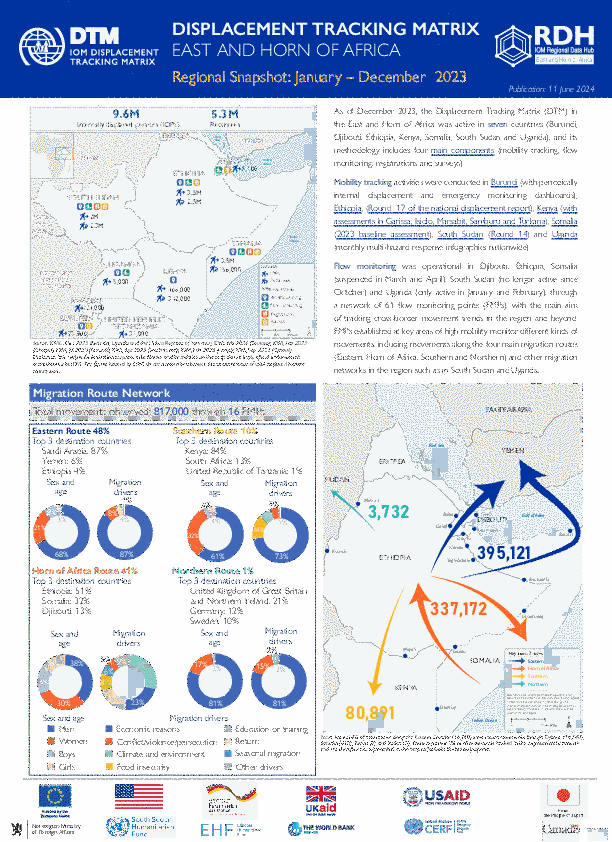-
Countries
-
Data and Analysis
-
Special Focus
-
Crisis Responses
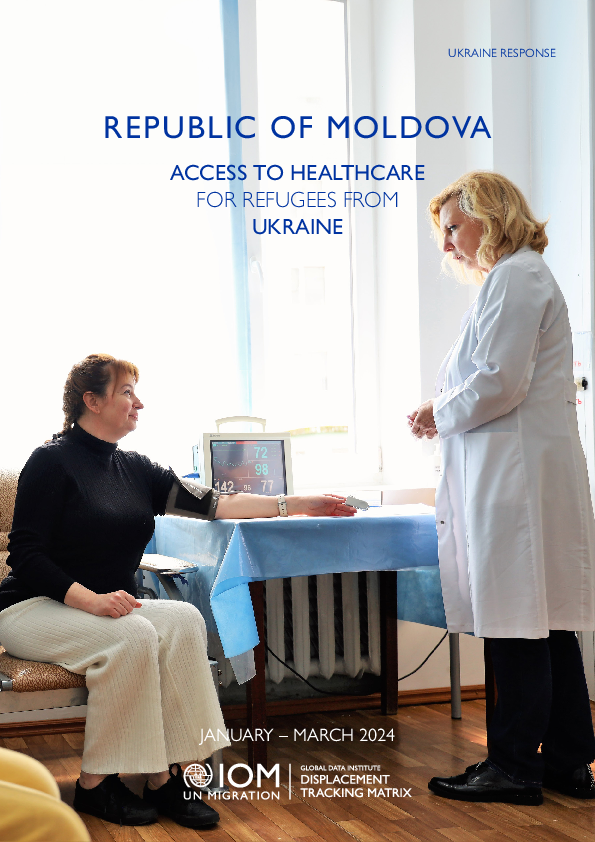
Contact
DTM Europe, DTMMediterranean@iom.int
Language
English
Location
Republic of Moldova
Period Covered
Jan 01 2024
Mar 31 2024
Activity
- Survey
- Flow Monitoring
The IOM’s Displacement Tracking Matrix collected data through Surveys with refugees in the Ukraine Response region from January to March 2024. In the Republic of Moldova, a total of 1,507 surveys were collected. This report focuses on the characteristics, socio-demographic composition, challenges, and needs of the displaced population in the Republic of Moldova, with a particular emphasis on healthcare and the medical needs of the respondents.
Key findings:
- 39% of respondents have or live with people with specific needs or serious medical conditions, while 2% reported living with a pregnant or lactating women.
- Main health issues for women include chronic disease or serious medical conditions (25%), difficulty walking (5%), visual impairment (3%), and hearing impairment (3%).
- Main health issues for men include chronic disease or serious medical conditions (48%), difficulty walking (5%), visual impairment (5%) and hearing impairment (2%).
- Health related needs reported by the respondents include medication (43%), health services (36%), and mental and psychosocial support (2%).
- The most reported barriers to accessing health care were costs (59%), long queues (35%), language barrier (19%), unavailable services (18%), and lack of documents (17%).

Contact
DTM Europe, DTMMediterranean@iom.int
Language
English
Location
Republic of Moldova
Period Covered
Jan 01 2024
Mar 31 2024
Activity
- Survey
- Return Intention
- Flow Monitoring
IOM’s Displacement Tracking Matrix (DTM) collects data on Ukrainian nationals and Third-Country Nationals (TCNs) that were crossing back to Ukraine from or through the Republic of Moldova, either for temporary stay or prospective return. The survey focuses on the return intentions, duration of displacement, destinations, assistance, and experiences of unequal treatment of the respondents. A total of 1,800 surveys were collected between January and March 2024.
Key findings:
- 87% of Ukrainian respondents planned to go for a short visit, 7% intended to stay in Ukraine (prospective returnees), while 6% were not sure about their intentions.
- The majority (69%) been residing in the Republic of Moldova, 9% in Romania, 5% in Germany. The remaining 17% stayed in other countries.
- 83% were going back to their Oblast of origin, while 17% were going back to a different Oblast.
- 43% had been displaced between January and June 2022.
- 67% crossed back to Ukraine twice or more since 2022. 10% crossed more than 10 times.
- 79% of prospective returnees and 91% of short-term visitors reported having received assistance since their displacement.
- Main priority needs that were cited by respondents include financial support (43%), medicine and health services (27%) and personal safety and security (22%).
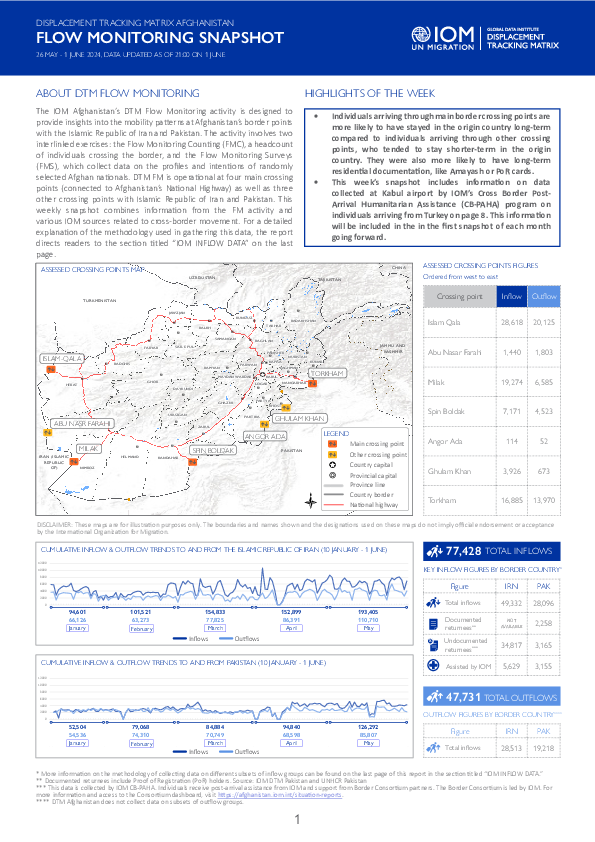
Contact
DTMAfghanistan@iom.int
Language
English
Location
Afghanistan
Period Covered
May 26 2024
Jun 01 2024
Activity
- Survey
- Flow Monitoring Survey
- Flow Monitoring
The IOM Afghanistan’s DTM Flow Monitoring activity is designed to provide insights into the mobility patterns at Afghanistan’s border points with the Islamic Republic of Iran and Pakistan. The activity involves two interlinked exercises: the Flow Monitoring Counting (FMC), a headcount of individuals crossing the border, and the Flow Monitoring Surveys (FMS), which collect data on the profiles and intentions of randomly selected Afghan nationals. DTM FM is operational at four main crossing points (connected to Afghanistan’s National Highway) as well as three other crossing points with Islamic Republic of Iran and Pakistan. This weekly snapshot combines information from the FM activity and various IOM sources related to cross-border movement. For a detailed explanation of the methodology used in gathering this data, the report directs readers to the section titled “IOM INFLOW DATA” on the last page.
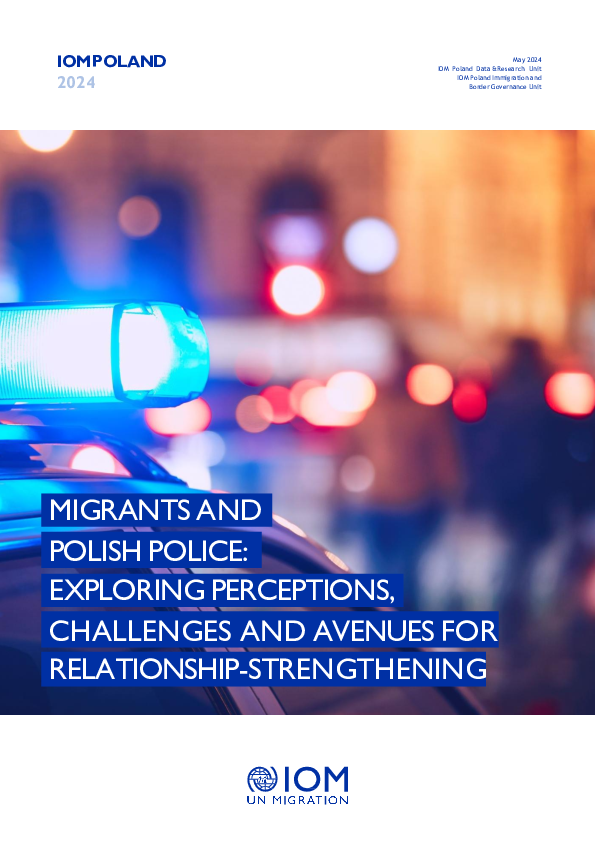
Contact
DTM Europe, DTMMediterranean@iom.int
Language
English
Location
Poland
Period Covered
Dec 01 2023
Apr 30 2024
Activity
- Survey
- Community Perception
This study aims to provide insights into interactions, perceptions, and potential areas for improvement in the relationship between non-Ukrainian migrants in Poland and Polish law enforcement with a specific focus on the Polish Police. The report encompasses our main research findings as well as recommendations for both Polish law enforcement's engagement with non-Ukrainian migrant communities and future humanitarian programming.
Disclaimer: This report was published by IOM Poland's Data and Research Unit, and is not based on DTM tools or methods. The report is featured here for convenience of dissemination and based on its relevance to the Ukraine Regional response.
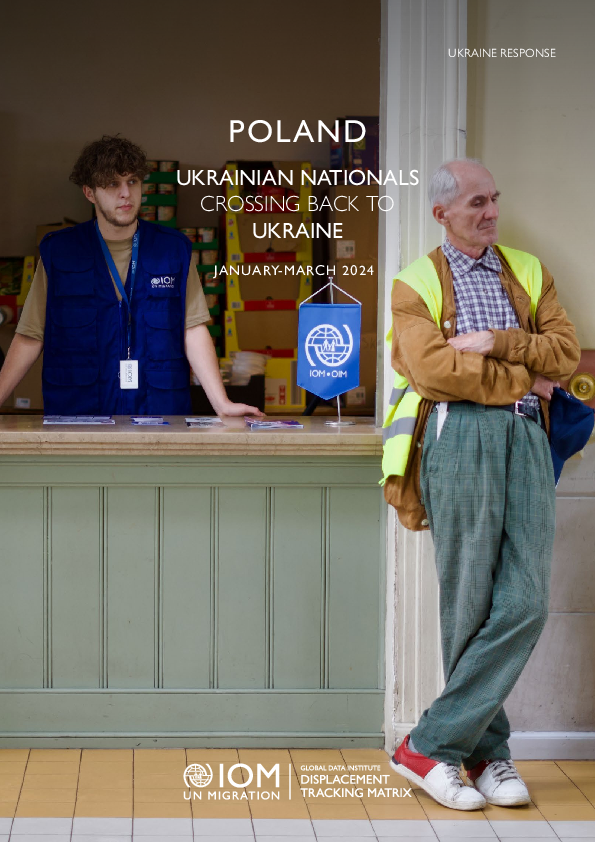
Contact
DTM Europe, DTMMediterranean@iom.int
Language
English
Location
Poland
Period Covered
Jan 01 2024
Mar 31 2024
Activity
- Survey
- Return Intention
- Flow Monitoring
IOM’s Displacement Tracking Matrix (DTM) collected data on Ukrainian nationals and Third-Country Nationals (TCNs) who crossed back to Ukraine from Poland, either for a temporary stay or permanent return after a period of displacement abroad. The survey focuses on the return intentions, duration of displacement, destinations, assistance, and experiences of discrimination of 361 Ukrainian respondents surveyed between January and March 2024.

Contact
DTM Sudan; dtmsudan@iom.int
Language
English
Location
Sudan
Snapshot Date
Jun 11 2024
Activity
- Mobility Tracking
- Baseline Assessment
Overview:
This report provides an overview of the total population of internally displaced persons (IDPs) in Sudan, including those displaced both before and after the onset of conflict on 15 April 2023.
The displacement crisis in Sudan has been unfolding for over two decades, with roots in the Darfur conflict beginning in 2003. Prior to the onset of conflict on 15 April 2023, Sudan already hosted an estimated 3,820,772 IDPs. The majority (80%) reportedly originated from Darfur states, and most were initially displaced between 2003 and 2010. Of these IDPs, many experienced secondary displacement after 15 April 2023. Since 15 April 2023, an estimated 7,262,187 individuals were displaced internally within Sudan — including those who experienced secondary displacement.
When accounting for those displaced both before and after 15 April 2023, DTM estimated that Sudan hosted a total of 10,095,054 IDPs.
Key Findings:
- An estimated total of 10,095,054 IDPs were displaced across 8,239 locations, in 183 localities in all 18 states in Sudan.
- An estimated 7,262,187 individuals were displaced internally within Sudan since 15 April 2023.
- An estimated 26 per cent of IDPs who were initially displaced prior to the onset of current conflict experienced secondary displacement since 15 April 2023.
- Approximately 2,170,592 individuals crossed borders into neighbouring countries since 15 April 2023.
- The top states of origin among IDPs were Khartoum (36%), South Darfur (21%), and North Darfur (12%).
- The states hosting the most IDPs were South Darfur (18%), North Darfur (13%) and Central Darfur (9%).
- Over half (55%) of IDPs were reportedly children under the age of 18-years-old.
Note: The number of IDPs displaced post 15 April 2023 (7,262,187 IDPs) includes the estimated 987,905 IDPs who were initially displaced prior to 15 April 2023 and experienced secondary displacement since 15 April 2023. DTM Sudan defines an internally displaced person as any person who has been forced or obliged to flee from their habitual residence due to an event dating from 2003 onwards.
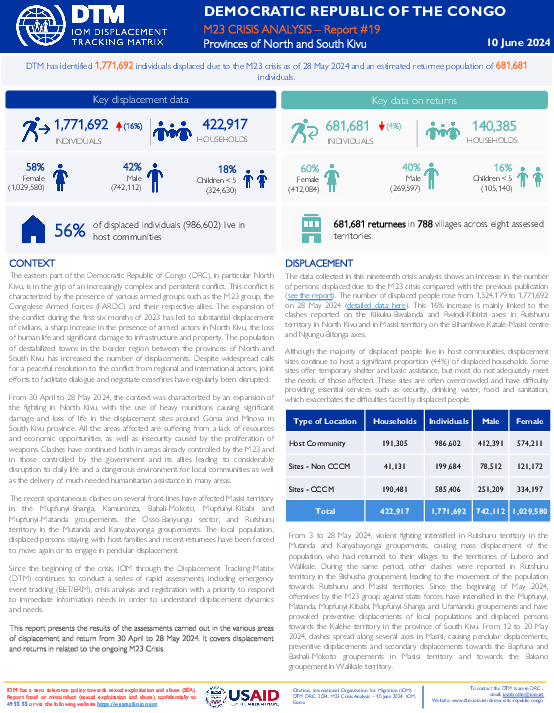
Contact
DTM DRC, iomdrcdtm@iom.int
Language
English
Location
Democratic Republic of the Congo
Period Covered
Apr 30 2024
May 28 2024
Activity
- Mobility Tracking
- Event Tracking
The eastern part of the Democratic Republic of Congo (DRC), in particular North Kivu, is in the grip of an increasingly complex and persistent conflict. This conflict is characterized by the presence of various armed groups such as the M23 group, the Congolese Armed Forces (FARDC) and their respective allies. The expansion of the conflict during the first six months of 2023 has led to substantial displacement of civilians, a sharp increase in the presence of armed actors in North Kivu, the loss of human life and significant damage to infrastructure and property. The population of destabilized towns in the border region between the provinces of North and South Kivu has increased the number of displacements. Despite widespread calls for a peaceful resolution to the conflict from regional and international actors, joint efforts to facilitate dialogue and negotiate ceasefires have regularly been disrupted.
From 30 April to 28 May 2024, the context was characterized by an expansion of the fighting in North Kivu, with the use of heavy munitions causing significant damage and loss of life in the displacement sites around Goma and Minova in South Kivu province. All the areas affected are suffering from a lack of resources and economic opportunities, as well as insecurity caused by the proliferation of weapons. Clashes have continued both in areas already controlled by the M23 and in those controlled by the government and its allies leading to considerable disruption to daily life and a dangerous environment for local communities as well as the delivery of much needed humanitarian assistance in many areas.
The recent spontaneous clashes on several front lines have affected Masisi territory in the Mupfunyi-Shanga, Kamuronza, Bahali-Mokoto, Mupfunyi-Kibabi and Mupfunyi-Matanda groupements, the Osso-Banyungu sector, and Rutshuru territory in the Mutanda and Kanyabayonga groupements. The local population, displaced persons staying with host families and recent returnees have been forced to move again or to engage in pendular displacement.
Since the beginning of the crisis, IOM through the Displacement Tracking Matrix (DTM) continues to conduct a series of rapid assessments, including emergency event tracking (EET/ERM), crisis analysis and registration with a priority to respond to immediate information needs in order to understand displacement dynamics and needs.
This report presents the results of the assessments carried out in the various areas of displacement and return from 30 April to 28 May 2024.
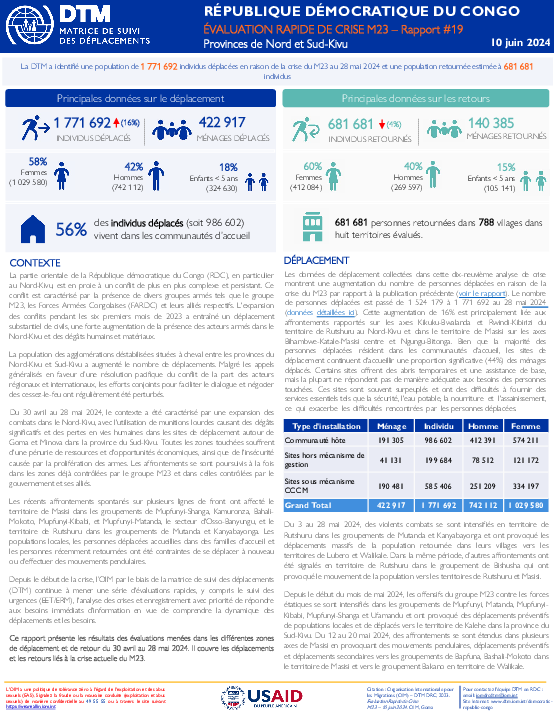
Contact
DTM DRC, iomdrcdtm@iom.int
Language
French
Location
Democratic Republic of the Congo
Period Covered
Apr 30 2024
May 28 2024
Activity
- Mobility Tracking
- Event Tracking
La partie orientale de la République démocratique du Congo (RDC), en particulier au Nord-Kivu, est en proie à un conflit de plus en plus complexe et persistant. Ce conflit est caractérisé par la présence de divers groupes armés tels que le groupe M23, les Forces Armées Congolaises (FARDC) et leurs alliés respectifs. L'expansion des conflits pendant les six premiers mois de 2023 a entraîné un déplacement substantiel de civils, une forte augmentation de la présence des acteurs armés dans le Nord-Kivu et des dégâts humains et matériaux.
La population des agglomérations déstabilisées situées à cheval entre les provinces du Nord-Kivu et Sud-Kivu a augmenté le nombre de déplacements. Malgré les appels généralisés en faveur d’une résolution pacifique du conflit de la part des acteurs régionaux et internationaux, les efforts conjoints pour faciliter le dialogue et négocier des cessez-le-feu ont régulièrement été perturbés.
Du 30 avril au 28 mai 2024, le contexte a été caractérisé par une expansion des combats dans le Nord-Kivu, avec l'utilisation de munitions lourdes causant des dégâts significatifs et des pertes en vies humaines dans les sites de déplacement autour de Goma et Minova dans la province du Sud-Kivu. Toutes les zones touchées souffrent d'une pénurie de ressources et d'opportunités économiques, ainsi que de l'insécurité causée par la prolifération des armes. Les affrontements se sont poursuivis à la fois dans les zones déjà contrôlées par le groupe M23 et dans celles contrôlées par le gouvernement et ses alliés.
Les récents affrontements spontanés sur plusieurs lignes de front ont affecté le territoire de Masisi dans les groupements de Mupfunyi-Shanga, Kamuronza, Bahali-Mokoto, Mupfunyi-Kibabi, et Mupfunyi-Matanda, le secteur d'Osso-Banyungu, et le territoire de Rutshuru dans les groupements de Mutanda et Kanyabayonga. Les populations locales, les personnes déplacées accueillies dans des familles d'accueil et les personnes récemment retournées ont été contraintes de se déplacer à nouveau ou d'effectuer des mouvements pendulaires.
Depuis le début de la crise, l’OIM par le biais de la matrice de suivi des déplacements (DTM) continue à mener une série d'évaluations rapides, y compris le suivi des urgences (EET/ERM), l'analyse des crises et enregistrement avec priorité de répondre aux besoins immédiats d'information en vue de comprendre la dynamique des déplacements et les besoins.
Ce rapport présente les résultats des évaluations menées dans les différentes zones de déplacement et de retour du 30 avril au 28 mai 2024
As of December 2023, the Displacement Tracking Matrix (DTM) in the East and Horn of Africa was active in seven countries (Burundi, Djibouti, Ethiopia, Kenya, Somalia, South Sudan and Uganda), and its methodology includes four main components (mobility tracking, flow monitoring, registrations and surveys).
Mobility tracking activities were conducted in Burundi (with periodic internal displacement and emergency monitoring dashboards), Ethiopia, (Round 17 of the national displacement report), Kenya (with assessments in Garissa, Isiolo, Marsabit, Samburu and Turkana), Somalia (2023 baseline assessment), South Sudan (Round 14) and Uganda (monthly multi-hazard response infographics nationwide).
Flow monitoring was operational in Djibouti, Ethiopia, Somalia (suspended in March and April), South Sudan (no longer active since
October) and Uganda (only active in January and February), through a network of 61 flow monitoring points (FMPs), with the main aim of tracking cross-border movement trends in the region and beyond. FMPs established at key areas of high mobility monitor different kinds of movements, including movements along the four main migration routes (Eastern, Horn of Africa, Southern and Northern) and other migration networks in the region such as in South Sudan and Uganda.
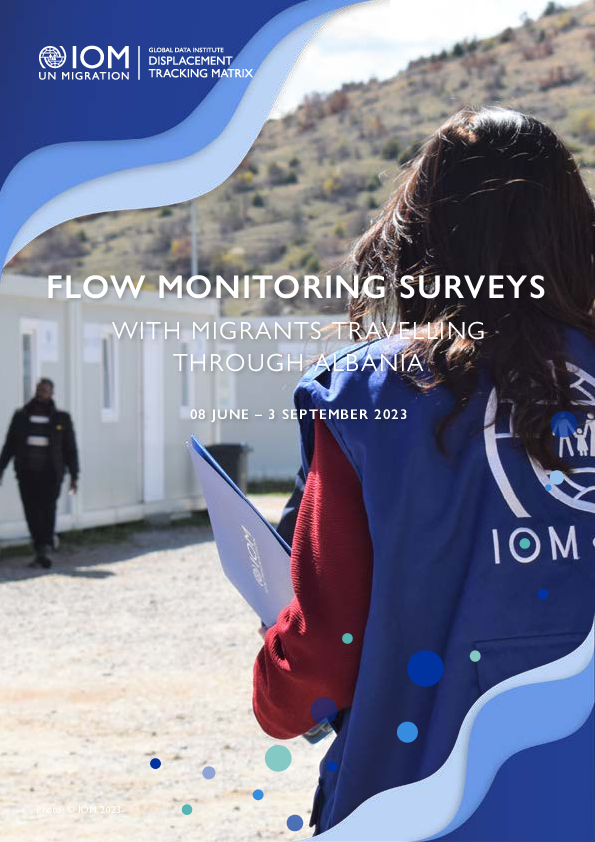
Contact
DTM Europe, DTMMediterranean@iom.int
Language
English
Location
Albania
Period Covered
Jun 08 2023
Sep 03 2023
Activity
- Survey
- Flow Monitoring
This report presents the results of the second round of the Displacement Tracking Matrix (DTM) Flow Monitoring Surveys (FMS) implemented in Albania. The data was collected across Albania from 8 June to 3 September 2023, with a total of 128 individual respondents.
FMS provides a snapshot of the profiles, experiences and needs of migrants transiting through Albania. The survey asks questions on demographics, education and employment backgrounds, the circumstances of the migration journey and migration factors, as well as future intentions.
